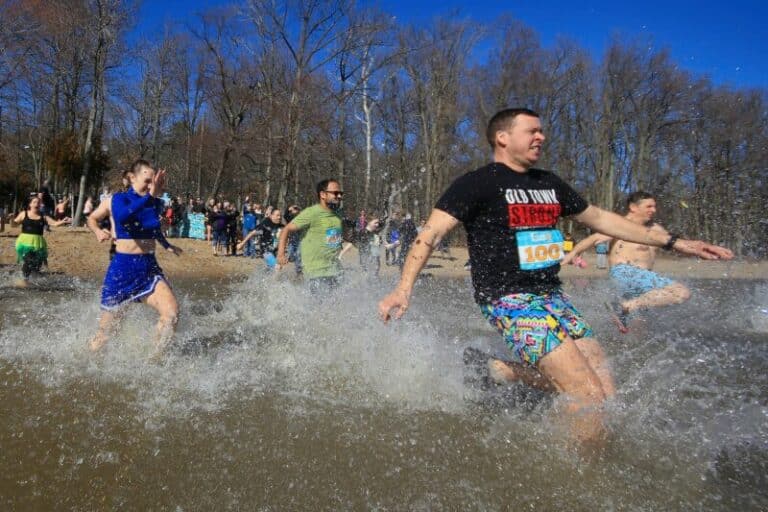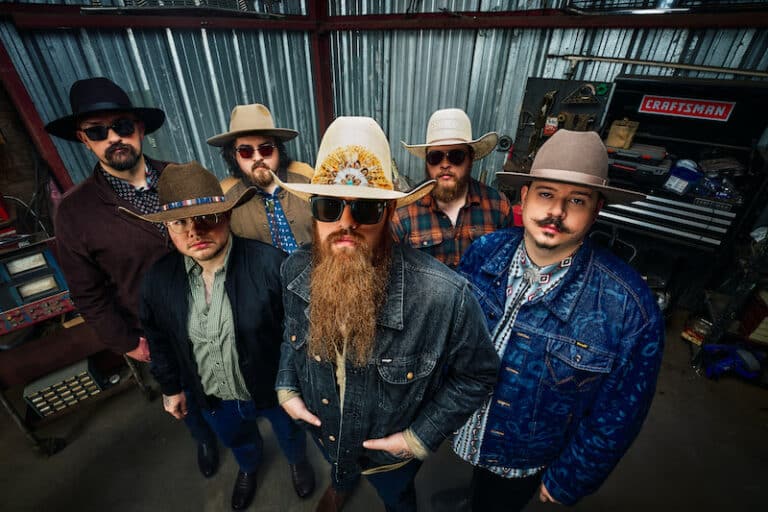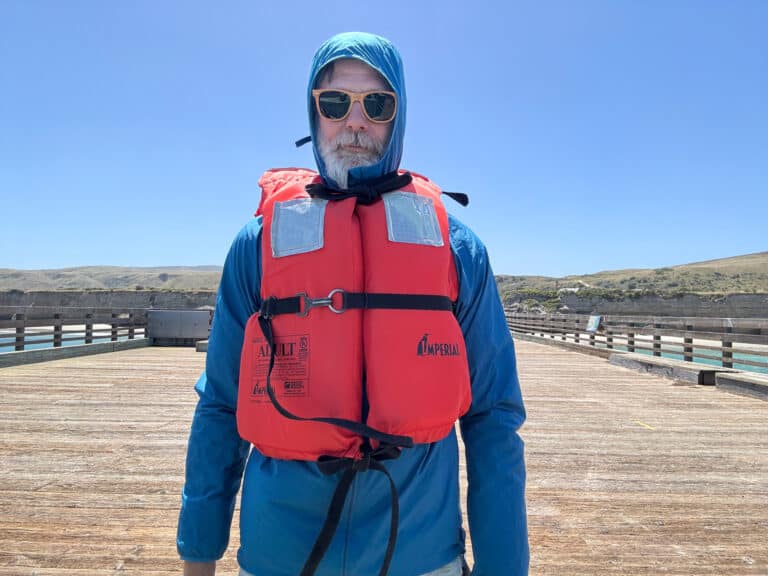Here’s the trouble with having a job: It takes up so much of your free time—time you could be using to hike, bike, run, etc. Alas, food must be bought and bills must be paid, so how do you find time to pursue your outdoor passions when you have the 9-to-5 weight around your neck? Take inspiration from the following five individuals who decided to turn those passions into full-time gigs.
APPALACHIAN TRAIL RIDGERUNNER
Susan Powell, age 28, is a full-time Ridgerunner for the Appalachian Trail Conservancy. From March until November, Powell hikes the A.T. through Great Smoky Mountains National Park, helping hikers and performing trail and shelter maintenance.
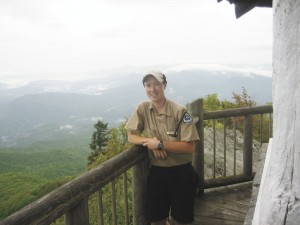
Describe a typical day “at the office.”
I wake up at 6:30, eat breakfast, pack-up, and I’m on the trail by 7:30. I hike a few miles, clearing trees that have blown down, talking to all hikers I meet, and checking for problem areas on the trail. I clean out the privy and pick up trash at each shelter. I also check springs for good flow and make sure the bear cables are working properly. Usually, I spend a lot of time talking to hikers about the trail, weather conditions, bear issues, and whatever else they need to know. At the end of the day, I make camp, eat dinner, relax, and write my daily report. I’m asleep by 9 or 10 pm.
Is the A.T. in the Smokies as crowded as everyone says? Is it as beautiful?
It’s definitely as beautiful but not as crowded. All you need to do is go about three miles beyond a trailhead and then it is a lot less crowded. But on the other hand, I’ve only spent three nights by myself the whole five months I have been out here so far. There are people around most of the time on the A.T., but not as many on the other trails in the park.
How many nights a year do you sleep on the trail?
Approximately 120-130 nights a year.
Do you ever get sick of hiking, or sleeping in shelters?
It’s pretty rare for me to get sick and tired of hiking. I don’t even mind sleeping at the shelters. I guess I just really love to hike and have found a job to match that I love. I do miss sleeping in my own bed from time to time.
You mentioned cleaning privies. Is that the worst part of your job?
It’s actually not that bad. We keep a designated privy shovel at each shelter. Just insert into hole and “knock down the cone.” I will let your imagination run with that one. Then we wipe it down with bleach and add more mulch to the buckets. The whole process takes five minutes. The worst part of my job is probably being away from home for an extended period of time. Or hiking with wet feet.
What’s the best moment you’ve ever had on the job?
My best moment was probably being a resource for about 20 thru-hikers who were stuck at Silers Bald Shelter in a foot and a half of snow in April. And the snow was pretty fun to hike in when it finally stopped snowing and was sunny.
How often are you “fighting” with the bears?
I usually see a bear or two every patrol, but for the first three months I was out here, I didn’t see one. I wouldn’t say I “fight” the bears. But I do throw a mean curve ball if they get too close to the shelter. That happens every two weeks or so and sometimes I am asked to stay at the same shelter a few days in a row to deal with the same bear.
Any advice for someone interested in becoming a Ridgerunner?
I started dreaming about a job as a professional backpacker when I started backpacking about 10 years ago. I never knew it could be a reality, but here I am. My advice is to start volunteering for your local trail clubs, and if you can, volunteer for a week or more for the Appalachian Trail Conservancy on one of their trail crews. Become certified in Wilderness First Aid or First Responder. Oh yeah, and a thru-hike of the Appalachian Trail doesn’t hurt.
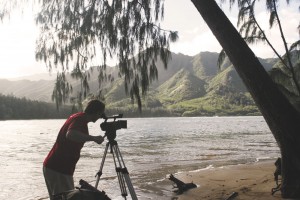
PADDLING FILM PRODUCER
John Grace, age 33, is owner of Penstock Productions, producers of Lunch Video Magazine, a quarterly video magazine devoted to steep creek and expedition whitewater paddling. Asheville, N.C.
You make kayaking movies. Does it get any cooler than that?
It’s a great job, but people don’t understand the elements that go into this business, like production, sales, filling orders. If you could be a fly on the wall, you’d see a lot of stressful times in the LVM office. It’s just like a car company.
What’s the hardest part of the job?
Courting the client and trying to convince companies that sponsoring our projects is going to be a value when they’re so tight with dollars. Then there’s the production side of things. We shoot probably 15 hours of raw footage to end up with one hour of edited content. After we shoot, it takes 30 to 40 days to edit one issue of LVM.
Why do you make paddling films?
I do it to be on the river. This job allows me to have the most free time on the water. Granted, sometimes that time on the water is frustrating because I’m carrying a huge camera and I’m thinking about setting up the next shot, but I’m still on the river. Plus, everyone likes adventure, and that’s what we give them with LVM.
How often do you get to paddle?
I paddle three days a week usually. Then I take about four trips a year where I paddle 10 to 20 days straight. I’m supposed to be in Quebec right now, but I lost my passport.
You travel, you paddle, you make films, and it pays the bills. What’s your secret to success?
You always have to realize you don’t know shit. The second you feel like you’ve got it figured out, you’re done. We’ve never been the big fish with the big sponsorship. We’d just as soon work with smaller sponsors for longer periods of time. We try to involve as many people as possible, and in the back of our heads we realize that we’re just not that important.
What’s next for LVM?
We’re working on the next issue of LVM and creating a new website that gives the user more control and allows us to expand into other activities like rock climbing and mountain biking. If it’s ever gonna grow from a business standpoint, we have to expand into other sports.
Any advice for kayakers looking to get into filmmaking?
Go for it. Become as affiliated with as many people in the industry as you can. Before you ask for something, give something away. And be realistic about where it’s going to end up. Look around you. Nobody’s making $70,000 a year doing this.

RUNNING CAMP DIRECTOR
Zika Rea, age 33, is director of ZAP Fitness Foundation, a non-profit training center for Olympic hopeful distance runners and an adult recreational running camp in Blowing Rock, N.C.
Why did you want to create a nonprofit training facility for runners?
We wanted to help emerging distance runners, and we figured the best way to do that was to put whatever money was coming in from the adult recreation camps back into supporting the elite athletes. When we began, there were a number of adult camps around and a couple of elite groups, but nobody was combining the recreation side with the elite side. Most runners never see elite athletes, other than their picture in the paper the day after they won the race.
Did your family and friends think you were crazy?
Most people didn’t understand what we were trying to do. They shook their heads. Some even said there weren’t enough good distance runners in America to fill the camp. But seven years later, it’s still working.
Describe your job.
I mainly manage the business side of things: planning the camps, paying the bills. It’s no different than running any other business, except that the outcome is really positive for a lot of different people. It may sounds cheesy, but working with elite athletes and recreational athletes is really rewarding. Life-changing events happen here. People get motivated and inspired.
Do you get to run often?
I used to run with the athletes every morning at Moses Cone, then I’d start working. But we have a four-month old, so my running schedule is sporadic. Sometimes I run six times a week, sometimes I run once a week.
What’s your dream job?
Being a farmer. We have some property with blueberry bushes and apple trees. If I could do anything, I’d work in the dirt.
If you weren’t running ZAP, what sort of a job do you think you’d have?
I probably wouldn’t have ended up in the running field at all. I could see taking my competitive side into the business world, probably working a desk job somewhere.
Any advice for those interested in becoming a running coach?
My advice for anyone wanting to start a business, whether it’s coaching runners or opening a restaurant, is this: You think it’s going to be cool and you’ll hang out with other runners, but in reality, a business is a business. Accept early on that you’ll be managing the business side of things as well as hanging out with runners, and you’ll be fine.

CLIMBING GEAR DESIGNER
Mike Grimm, age 47, is head gear designer, tester, and co-owner of Misty Mountain Threadworks, makers of climbing harnesses, bouldering crash pads, and climbing bags, headquartered in Boone, N.C.
How did you end up designing gear at Misty Mountain?
I was working here for 11 years. I was 34 and still wondering what I was going to do with my life. The opportunity to buy half of the company opened up, and I was having fun at my job and figured it would be even more fun to design the gear I was making.
Describe a typical day on the job.
It’s still a job. My typical day includes checking emails, downloading internet orders, checking on production, ordering materials, fixing machines, arranging the production schedule. I also do a lot of testing, which is more than just climbing. We have a test lab full of machines I made to test our products. We have a wooden test dummy and a hydraulic pull machine that pulls the harness with 3,600 pounds of pressure. If it doesn’t break, release, or slip, it passes the test.
Favorite part of the job?
Product testing, which is what I call climbing. But the design is fun too. It’s neat to have an idea and work it through. Design is 20 percent imagination and 80 percent hard work. It has its ups and downs and lots of road blocks, but when you work through it, it’s rewarding. You can’t force it though. It has to evolve.
Any product you’re most proud of designing?
I’m probably most proud of the adaptive climbing harnesses I’ve designed. The Arc in particular. It took me 400 hours of design over the course of a year. I feel good about it because of what it allows people to do. That harness gets them out of a wheelchair and allows them to climb a tower or ropes course.
 How often do you get to climb?
How often do you get to climb?
Every Saturday and then usually two times during the week. I try to have at least one other climber working here. That way I always have a partner who wants to get out and “test product.”
What would you be doing if you weren’t designing gear at Misty Mountain?
I studied furniture design at Appalachian State so I’d probably be in furniture design or construction. I like to build things. I see a lot of people who don’t enjoy their work. That’s a shame when you think about the amount of time we all spend at our jobs.
You have what many would consider to be a dream job. Is there any other job you wish you had?
I definitely have a dream job, but sometimes I envy the freedom of sales reps. If I were single without a family, I wouldn’t mind traveling around the region, climbing different crags and meeting climbers.
Any advice for those interested in designing gear for a living?
Persistence is the key. Don’t get into this for financial rewards. Most people don’t. Most people have an idea that they want to see through. It’s hard for me to tell people how to go about getting this kind of job because I never had a set plan. It all kind of fell together. I just go with the flow.

MOUNTAIN BIKE GUIDE
Chris Scott, age 40, is owner of Shenandoah Mountain Touring, a backcountry mountain bike guide service, taking clients on tours of Virginia singletrack. Harrisonburg, Va.
Describe your typical day.
I put in about as much computer time as anyone. I work on a lot of advocacy projects for the Virginia Bicycle Federation and IMBA. Right now, I’m looking over a scoping notice for a proposed action on the GW for some logging that could affect some trails.
Does being a mountain bike guide pay the bills?
I live cheap. I own a house with rental units so I don’t have a massive mortgage payment looming over my head. It’s allowed me to cultivate this job over the last 10 years. But it’s only been the last two years that I haven’t had to have something else to help pay the bills. For a while, I was a bike messenger in D.C. The faster you pedaled, the more you got paid. It was awesome.
Best part of your job?
Getting to ride often is definitely the best part of my job. I ride at least three times a week. I don’t get to guide as often as you’d think. I have people help me with that. We do Girl Scout Tours and Lutheran Camp Tours, but I still get out a couple of times a month on a tour.
Is guiding bikers as fun as it sounds?
It’s tons of fun. You’d think dealing with different skill levels on a five day backcountry trip would be difficult, but as long as everyone has a good attitude, it’s still fun. I will say I’ve finished more tours on other people’s bikes than my own. They get out there and their bike falls apart, so I rig it into a singlespeed and they ride mine. Once, I took a married couple on the IMBA Epic Southern Traverse. We didn’t get off the trail until 10 p.m., and that was after a nice hike out in the dark. The loving husband just put clipless pedals on his wife’s bike prior to the ride. But it was still a great time because they had a great attitude.
What’s the average salary for a mountain bike guide?
It’s only about $12,000 a year. Most guides have other jobs. I own my own company and I don’t think I’ve ever made more than $10,000 a year guiding.
Any advice for bikers wanting to become backcountry guides?
Work with land managers, partner with clubs, and do lots of trail work. And don’t claim your trails are the best in the world. No one’s trails are the best in the world. •
